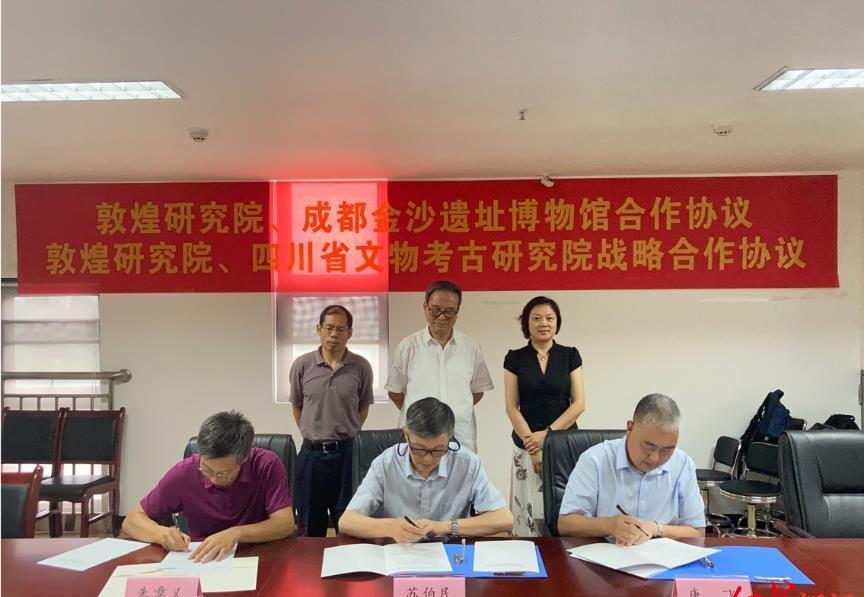Today (July 11) morning, the signing ceremony of the strategic cooperation framework agreement between Jinsha Site Museum and Dunhuang Research Institute was held in Guanghan. Zhu Zhangyi, director of Jinsha Site Museum, introduced: "This cooperation with Dunhuang Research Institute focuses on the protection and restoration of the earthen site, digital construction, cultural heritage site monitoring, academic research and cultural display. ”

Signing site
Encounter the world's problems of hydration and soil site protection
Earthen ruins refer to the relics left over from various activities such as production and life in human history with soil as the main building material. As an important carrier of Chinese civilization, earthen sites not only account for a large proportion of China's cultural heritage resources, but also contain extremely rich historical information, which is an important evidence for studying the origin and development process of Chinese civilization, and has great historical, scientific and artistic value. In terms of form, the earthen ruins are divided into above-ground earth sites, such as the Great Wall, Pingyao Ancient City, etc., as well as underground earthen sites, such as various mausoleums, terracotta warriors and horses pits, etc. From the perspective of the preservation environment, the earthen sites are divided into earthen sites in a dry environment, such as the ancient city of Loulan in Gansu, and the earthen sites in a humid environment, such as the Jinsha site in the Chengdu Plain.
In particular, the latter's sacrifice area was historically the place where the ancestors of the ancient Shu Jinsha held riverside sacrifices. For hundreds of years, they buried priceless treasures such as gold ornaments and gold masks of the sun god bird in the wetlands by the river. Today, the Jinsha Site Museum, built on the site of the original Jinsha site, preserves the original state of the site sacrifice area, presenting visitors with the large-scale sacrificial relics of the Shang and Zhou Dynasties, which is currently the most complete preservation in China: the ancient river channel stretches across the hinterland of the sacrifice pit, and tons of ivory are still buried in it, waiting to be seen again. Therefore, the sacrifice area of the Jinsha site is not only the birthplace of most precious cultural relics, but also the mystery of our continued solution to the mystery of ancient Shu in the future.
However, the relative humidity in the atmospheric environment, changes in light and ultraviolet intensity, as well as the moisture content and soluble salt species content in the soil of the site may cause erosion damage, especially the humid climate of the Chengdu Plain, the urban rivers that flow through and the groundwater that changes drastically from time to time, which pose a great threat to the Jinsha site sacrifice area, and its protection has become a long-term topic of the Jinsha Site Museum.
Jinsha Site Museum Ruins Museum
Join hands to overcome the difficulties in the protection and utilization of earthen ruins
As an internationally influential scientific research base for the protection of earthen sites, Dunhuang Research Institute is a comprehensive specialized institution established by the state responsible for the protection, management and research of the World Cultural Heritage Dunhuang Mogao Grottoes, the national key cultural relics protection unit Anxi Yulin Grottoes and dunhuang West Thousand Buddha Caves, and takes the lead in carrying out research on the theory, reinforcement materials, technology and equipment of soil site protection in China.
In January 2021, the project "Research on the Deterioration Process and Protection Technology of Soil Sites under Multi-field Coupling" was officially launched by Dunhuang Research Institute as the lead unit, aiming to study the effects of multiple physical factors such as humidity, temperature and light on soil sites. The project is one of the cultural heritage protection and utilization projects of the Ministry of Science and Technology's "13th Five-Year Plan" National Key Research and Development Plan - "Monitoring, Early Warning and Prevention of Major Natural Disasters". As a demonstration base for comprehensive protection technology in humid environment, Jinsha Site Museum took the sacrifice area, the forefront of soil site protection, as the object, and participated in the sub-project "Research and Demonstration of the Synergy Mechanism of Comprehensive Protection Measures for Earthen Sites" as a cooperative unit, laying a practical foundation for this signing. The two senior soil site protection units have joined forces, and their research results will surely comprehensively improve the overall level of china's land site protection.
Monitoring equipment in the Jinsha Site Museum Relics Hall
Focus on difficult points to carry out talent exchange and training
The agreement stipulates that the two sides will take the protection and repair of the jinsha site sacrifice core protection area as the entry point, jointly carry out key technical research in major projects, carry out special research, jointly declare provincial and national scientific research topics on technical problems, and improve the academic level of both sides and promote the solution of a number of related major academic problems through the planning and implementation of a series of major projects.
At the same time, Sands and Dunhuang will also give full play to their respective advantages in scientific research and talent team building, send professionals to each other's units for study and exchange, jointly carry out technical training, organize academic reports or lectures, and promote the cultivation of talents on both sides through various means. The joint efforts of the nine-colored deer and the sun god bird will inevitably compose a vivid and exciting new picture for the protection of China's cultural heritage.
Red Star News reporter | Qiao Xueyang Zeng Qi
Editor| Li Xueli
(Download Red Star News, there are prizes for the newspaper!) )